Chevrolet Volt test drive since 2010 hatchback
Comparative Chevrolet Volt and Toyota Prius Phv. Between electricity and gasoline
 Fans of electric vehicles adore the fact that there are a lot of gas stations everywhere. Since this gives them a lot of opportunities to pass by with an important look in absolute silence. They love these cute rituals, but they are in the minority. In fact, most of us consider electric cars to be absolutely unrealistic. With the help of such a vehicle, you can get to work, ride a couple of places, but their limited range means that there should always be transport with a gasoline engine, just in case.
Fans of electric vehicles adore the fact that there are a lot of gas stations everywhere. Since this gives them a lot of opportunities to pass by with an important look in absolute silence. They love these cute rituals, but they are in the minority. In fact, most of us consider electric cars to be absolutely unrealistic. With the help of such a vehicle, you can get to work, ride a couple of places, but their limited range means that there should always be transport with a gasoline engine, just in case. Is there a solution to this problem? Yes, these are hybrids that can be recharged from the network, such as the Chevrolet Volt and Toyota Prius Phv (Plug-in Hybrid Vehicle). They combine two systems at once: use electric traction when there is such an opportunity, and if the battery is discharged, without delay switch to traction from the gasoline engine. We want to warn you right away: in this case, it is impossible to identify the best using simple calculations. When it comes to comparing hybrids with the possibility of recharging, such as Volt and Prius Phv, it is best to immediately focus on the gasoline side of the issue, considering electricity free.
The real cost of Plug-in hybrids
We can measure the cost of charging the battery in the same way as we can do this at a gas station. Carefully monitoring this aspect, we tested the supply of each car only on electric traction, as well as the cost of full charge of batteries. We used both the usual 120-volt network of the first level (ordinary outlet), and more prestigious, 240 volts, using special chargers.
When the battery charge ended, we did not stop. But let's go not just where their eyes look. We measured their economy (in terms of fuel) on a carefully calculated route that imitates the most ordinary road.
We came to the conclusion that it was according to these two parameters that there was not enough data to put the whole picture together, and therefore we conducted such a test. But if you are not of those who are interested in such complex numbers, then most likely, neither the Chevy Volta Prius, you will not be of interest to you in principle.
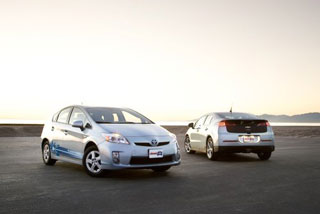 Gaze
Gaze Here is a simple figure for those who are not particularly strong in mathematics: 0.6. At the end of our test, the gap between Chevy Volt and Toyota Prius Phv was less than one point, it was an equal battle. But they arrived at the finish line with completely different roads, and they are far from being as similar as one could assume, looking at the final result of the test. At first glance, the main ingredients of Volt and Prius seem identical. Each has a four -cylinder gasoline engine. Each has two electric motors: the one that is more responsible for the movement and regeneration of energy during braking, and which is smaller on the patch: launches a gasoline engine, gives a small increase in power, regulates speed or generates electric traction.
Planetary transmissions in their transmission mix these three components, turning them into a smooth move forward, and complex computer software coordinates the entire process to obtain maximum efficiency.
It is such a scheme that takes place in most modern hybrid cars. Volt and Prius Phv are distinguished by their batteries with large lithium-ion modules, the dimensions of which significantly exceed the needs of simple brake regeneration.
The battery of Prius Phv is designed for 5.2 kWh, this is enough for 20-25 km drive exclusively on electric thrust after the battery full charging. VOLT is equipped with a more capacious 16 kWh battery, allowing it to drive as much as 55 km.
Details determine the difference
Upon closer examination, all similarities in terms of mechanics suddenly ceased to be such. Big PRIUS PHV electric motor with a capacity of 80 hp. (60 kW) should twist the front wheels. But as soon as its power begins to fall, which usually occurs at speed slightly over 100 km/h, a 1.8-liter gasoline engine with a 98 hp cycle with a cycle of a certificate with a capacity cycle is included in operation. No clutch, no speed switches, no hydraulics everything happens completely imperceptibly.
Such a transition from one type of thrust to another can occur at lower speed, for example, if you sharply press the accelerator pedal or when driving in the rise. Drivers who expected that having selected the EV regime, it is in it that they will move in such situations, they can be slightly confused, although almost everyone is ready to give up these expectations, as our further tests showed.
Like Prius, the main Volt electric motor, with a capacity of 149 hp (111 kW), sets the front axle in motion, but it does it differently. Like the competitor, its effectiveness is sharply reduced at a speed of 100-110 km/h, just when you want to add a little more. At this moment, the second electric motor comes to the help, and a gasoline unit with a capacity of 84 hp. With a working volume of 1.4 liters is still inactive. This system of Voltec contains as many as three clutches.
As soon as the battery’s charge ends, a gasoline engine is included in the operation: it sets in motion an auxiliary electric motor, which, in turn, supplies electricity to the main electric engine that continues to push the car. At higher speeds or in situations requiring more traction, the gasoline engine independently includes the system, mechanically contributing to acceleration, while continuing to feed the main electric motor with electricity.
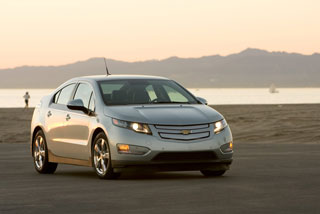 Test batteries
Test batteries Recently, ERA published the official data of the Chevrolet Volt. Its gasoline engine consumes 6.3 liters per 100 km, an electric unit of 36 kW per 160 km, and its range on one charge of the battery is 56 km. But this information is not particularly useful in this situation, since the agency has not published similar data on Prius Phv. Well, okay. We ourselves will experience and measure everything. Perhaps the data obtained by us will not coincide completely, but we will drive both cars along the same route in the same conditions, so that these data will be at least comparable. So let's get down.
We measured gasoline consumption by driving away both cars along our route with discharged batteries standard technique. We measured electricity consumption on a special section of the route using a special device that determines the number of consumed kilowatt hours with subsequent battery charging.
Our results look as follows:
Electricity consumption in EV mode (only electric trim is used):
VOLT 39.0 kWh for 160 km
Prius PHV 23.2 kWh for 160 km
Fuel consumption in HV mode (hybrid thrust):
VOLT 7.56 liters per 100 km
Prius Phv 4.98 liters per 100 km
Tax reserve on one charge of batteries in EV mode:
VOLT 54.5 km
Prius Phv 23.5 km
With the same driving manner, our Prius Phv spent 34% less fuel in mixed mode, and 41% less electricity in EV mode than VOLT.
Practical factor and some conclusions
Several of our editors live more than 80 km from the office, and therefore consider the plug-in hybrids from the position of the fact that these cars can drive more than 160 km on one charge. General Motors, on the contrary, especially emphasizes the VOLT belonging to the class of electric vehicles: it may be like that, but not constantly.
So, if these machines are not electric cars for all 100 percent, then which class can include these hybrid cars that can be charged from the outlet? Fortunately, the Society of Automobile Engineers has developed such a thing as a practical factor that helps solve problems like ours. However, it is not worth perceiving the factor of practicality as something that can be expressed in numbers: the word usefulness here implies energy intensity here, that is, the consumption of electricity.
Simply speaking, the factor of practicality reflects the obvious: the larger the electric car has a range on one charge of the battery, the more it will pass kilometers in EV mode. This factor is based on mathematical calculations and statistical calculations, although in the end it all comes down to the equation.
In the case of VOLT with it, 54.5 km on one charge means that it can be used in electric mode 57% of the time, while 23.5 km Prius are transferred to 31%. It is these data that we will use when summing up the results of the comparison.
In the first year, Chevrolet Volt will be sold by limited batches. Therefore, instead of nationwide prices for electricity and fuel, we will take the average prices of those regions where he will go on sale: the States of California, Connecticut, Michigan, New Jersey, New York, Texas, as well as Washington.
Electricity cost, kWh: 15.8 cents
The cost of gasoline: 78 cents per liter of fuel of the brand regulator, 85 cents per liter of fuel of the premium brand (this is how recommended to refuel volt).
Taking 24,000 km about 2,000 km per month for the average mileage, we calculated the consumption of both types of fuel and deduced the amount of monthly fuel costs:
Chevrolet Volt $ 99.87
Toyota Prius Phv $ 68.24
You can take a look at this on the other side: if you spent such an amount per month on refueling ordinary gasoline with a regular car, what consumption should this car have to drive the same 2,000 km in mixed mode? This is called fuel consumption based on its value.
Chevrolet Volt 6.35 l/100 km
Toyota Prius Phv 4.35 l/100 km
I think you noticed that our theoretical 6.35 liters in the case of VOLT differ slightly from 3.92 liters declared by the manufacturer. This is because ERA does not take into account the cost of fuel when converting the consumption of electricity into fuel consumption.
All this, of course, is insanely interesting for scientists, but in the real world, electricity and gasoline are independent of energy sources, their cost is calculated in different ways, which makes estimates and calculations of the ERA in the case of cars working on combined thrust, completely meaningless . We believe that the calculation scheme we proposed is much more realistic.
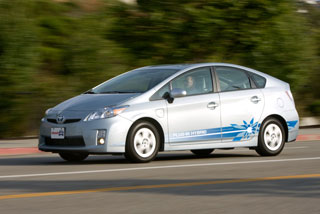 How do they go?
How do they go? Since this is a traditional comparative test, we drove both cars to our test track. Chevy Volt, despite the additional 170 kg on board, performed on an equal footing with Toyota Prius Phv. Before the test, both cars were charged from the outlet all night, which means they went to the start with completely charged batteries. For Prius Phv, this did not play any role, because, as we explained earlier, the engine starts only when something like a very sharp and quick start is required. The classic acceleration from a place to hundreds took 10.1 s, a quarter of a mile was passed in 17.4 seconds, the speed at the finish line was 128 km/h quite comparable to the usual Prius, which we tested. At first we checked the VOLT in completely electric mode, but in the end he went faster after our driver spent the entire supply of the battery, thereby using the gasoline engine. This gave an advantage of 0.2 seconds and an increase of 6.5 km/h to speed at the finish line: Volt on an electric protrusion accelerated to 100 km/h in 9.0 seconds, and the quoter passed in 16.6 seconds, accelerating at the finish 137.5 km/h.
In the test for the lateral acceleration, Volt escaped if such a slight gap in the results can be considered a leadership of 0.75G in Prius PhV and 0.77G in VOLT. True, on the slalom, the lag Prius increased, since it managed to accelerate only to 92.7 km/h, which looks very pale against the background of 96.9 km/h reached by the Volt.
The results of the VOLT in the test for a full stop at a speed of 100 km/h 37.79 m seem mediocre, since the previous Prius, which visited our training ground, did the same for 35.69 m. But Prius Phv weighs 170 kg more than its predecessor, And at the same time, he rides on the same thin tires with a dimension of 195/65 R15 in the end, its result was only 39.62 m.
We go out into the street
Even from the outside you can notice how differently these two are at low speeds, despite the fact that their suspensions are very similar: MacPherson suspension in the back and multi-link behind. Chevy Volt, being 6 cm below, 5 cm wider, and having wider P215/55 R17 tires, is literally chained to a roadbear at high speeds and is very sure of any turns of real roads. The electric amplifier, unfortunately, does not provide the steering wheel with the residual information content, and yet it is much more lively than that of Prius.
The positive impression of the management of the family car for trips over short distances is further enhanced by the smoothness of its move, the exceptional noiselessness of the work, at least until the moment when the supply of the battery runs out and the gasoline engine is included in the operation. But even at such moments in the Volt salon, much quieter, thanks to good sound insulation.
True, in an unpredictable flow of urban movement and hilly terrain, the engine is sometimes lost, especially when it has to work in a higher speed range than expected, i.e. Over 2000 often when moving, as if it only expects the moment to exclude electronics from the working process the following acceleration. At high speeds, a slight tinkling is heard, which makes you guess if this is the sound of the auxiliary engine.
Our Prius, on the contrary, is some kind of uncertain, more nervous and stretched, especially on a high-speed highway. It looks higher and thin, and this largely reflects how he goes. The epithet is not able to fully characterize its steering wheel.
It is impossible to call it absolutely silent, since the Prius Hybrid Synergy Drive system makes a whole palette of various sounds: there are moans, grunts, and clicks. Fans of hybrid cars can close their eyes to this, justifying this by the fact that these sounds mean some kind of activity, but we would prefer not to hear anything at all.
Salon fever
The VOLT tool panel equipped with a color display is attractive and functional, but you can’t say this about the central white slightly luminous console. The sensory control here is undoubtedly a technical breakthrough, but the mass of the same size and buttons located in dense rows are knocked down to distinguish it is difficult to distinguish. However, many of us have used a computer keyboard for more than a dozen years, but they are still sometimes scouring in search of the right key.
Our stable hostility to the central PRIUS panel, where the main devices are located, have not gone anywhere, I think you should not talk about this again, and we still believe that the parking button should not be taken separately. But, despite the above, spacious front console is easy to use, the buttons on it are successfully grouped according to the functions that they are designed to control.
Both cars have enough spaces for both your legs and over their heads, but our drivers, again, preferred Volt, offering a more convenient driver’s position, more space for his shoulders and telescopic adjustment of the steering column.
At the same time, a higher Prius roof line and its slightly longer base provide a mass of free space in the rear of the cabin and a generous trunk (577 liters against 300 liters of VOLT), which explains the popularity of this model among taxi drivers. Our tall colleagues noted that Volt had a rather close rear seat they had nowhere to put their legs, and the roof crushed so that it is unlikely that the Volt could become a star of the Vyuza.
In addition, only four will be able to take away, since its T-shaped battery passes exactly between the two rear seats. Nevertheless, the rear seats are very comfortable, and the hatch in the back looks fresh, we still doubt the practicality of such a solution, since there is no cargo fixation system in the trunk, and road noise penetrates the salon.
So how much do they cost?
The cost of our Chevrolet Volt starts at $ 41,000, including the cost of delivery to the dealership. The navigation system of this car is standard, but it is also equipped with leather seats, a rear view camera and polished aluminum casting discs, which ultimately increases its cost to $ 43,685.
Do not forget that the capacity of the VOLT battery, 16 kW, provides the buyer with the maximum tax compensation of $ 7,500, and this reduces its cost to $ 36 185. It is good, of course, but still a lot.
The price of Toyota Prius, unfortunately, is only approximate, since it is a technically a demonstration model that has not yet been sold. We took as a basis the cost of a conventional Prius and added to it the value of the Toyota system of the PHV 4,000 system. This increases the basic cost to $ 28 560, in addition, the navigation system in the case of Prius is an additional option, so the approximate price of the Prius PhV we tested will be about $ 30 590.
By purchasing Prius PHV, you can also count on state support, but the more modest capacity of its battery (5.2 kW) means that you will be compensated for only $ 2,917. This will reduce its theoretical cost to $ 27,673, i.e. As a result, it will cost $ 8,500 cheaper than VOLT.
True, this year (the first for the model), Chevrolet plans to sell only 10,000 such cars, so there will be no deficit in those who want to acquire them, even contrary to a fairly high cost. In addition, you will not be able to save these $ 8,500 by buying Prius Phv, since it simply is not on sale.
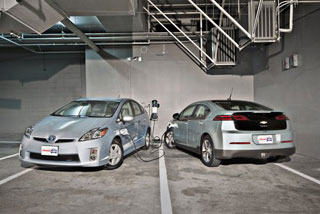 We are already foreseen a quick match-rare
We are already foreseen a quick match-rare The fact that Prius Phv does not yet exist is the very last straw that inclines the scales in favor of Chevrolet Volt. This is a hybrid that can be charged from an ordinary outlet, and in general it is a good car. If you go not far from you, and you are usually in no hurry, you can refute all existing prejudices and use the EV mode almost constantly. But the most important thing is that Chevy Volt is already produced, and it can be pulled now.
Moreover, in 2012 we expect a modification and improvement. It seems that it is worth starting from the iron unit of a 1.4-liter engine and its addiction to premium gasoline. Changes in this area will significantly improve the picture as a whole.
Toyota claims that Prius Phv will enter the market, but not earlier than 2012, i.e. in a year. By that time he will be a model of 2013. Toyota also hints that the lessons obtained during the 2010 model test will be taken into account, so that the production model should be stronger than one or even several parameters.
The lack of a leash and immunity to the range of PHV hybrids for many of us are the very decisive arguments when choosing between an electric car and a hybrid. And at the moment, Chevrolet Volt is the only player in this league.
Alternative opinion
Technical editor Jason Caveni:
The cost of operation is an important parameter when it comes to hybrids loading from the outlet, such as Chevrolet Volt and Toyota Prius Phv. But he is not the only one.
These cars will be bought by different people. At first, these will be fans of the presented technologies and environmentally conscious citizens, for whom the low cost of detention is more justified than a need. Then ordinary consumers will be interested in the model, for which simplicity, practicality and economy are important. And here it is possible two options for either the car will like it, or it will seem meaningless.
Among all the aspects that a person who acquires a hybrid car with the Plug-in system is considered, there is one common for everyone what to drive such a car. And here VOLT has an undeniable advantage over Prius. Toyota Prius is quiet, he has a spacious rear seat and the most disgusting handling among modern cars. No information on the steering wheel. Synthetic brakes. Uncertain acceleration. He is completely uninteresting for the driver.
The easiest way would be to delete the above from the discussion of the dynamic characteristics of the car. But those who understand the cars believe that a car that does not give its driver information about what is happening on the road cannot provide him with confidence. A confident driver is a safe driver, which is extremely important for other drivers on any road.
Volt is by no means a sports car, and even near sports, but at least it provides some effort on the steering wheel, let it also feel the readiness for turns and the ability to maintain the speed chosen by the driver (within the rational, of course, of course ), but this is confidence. It is these qualities that each of us seeks to receive, consciously or at a subconscious level.
As you can protect from the names of the models, Chevy Volt and Toyota Prius Phv can go using only a battery charge, but they have gasoline motors and gas tanks, so these are not electric vehicles.
The results of the test
The weight
Chevrolet Volt
Toyota Prius Phv
Subjective rating
2.5%
83.3
66.7
The rating must be taken! (Which of the cars from the point of view of the editorial office is better for the average buyer in this segment of cars)
2.5%
50.0
100.0
Assessment for 28 pre -agreed points (from the characteristics of the engine to the convenience of the rear seats)
20%
70.4
68.8
Equipment
20%
66.7
58.3
Driving qualities
15%
100.0
75.2
Fuel consumption
twenty%
70.8
82.9
Price
20%
39.3
48.6
Total score
100%
67.8
67.2
The final rating
one
2


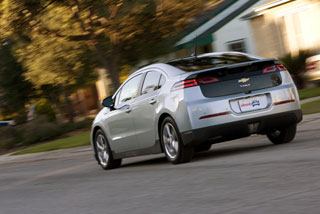

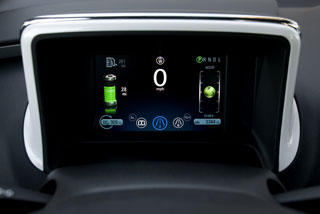



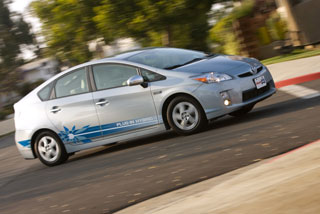
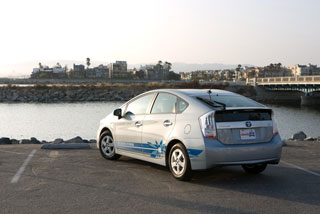
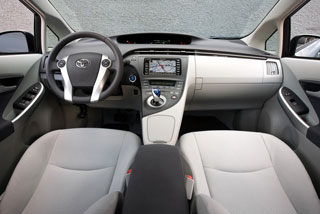
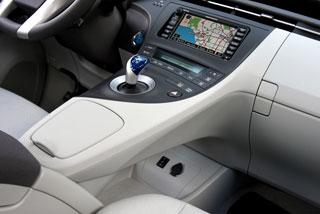


Source: Insideline








